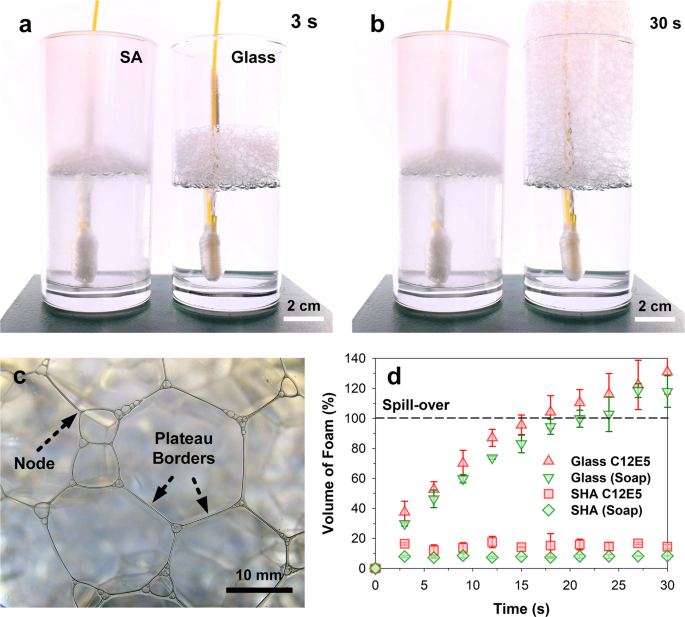Anti-Foam Control Solutions-- Efficient Foam Management for Industrial Applications
Anti-Foam Control Solutions-- Efficient Foam Management for Industrial Applications
Blog Article
Best Practices for Picking the Right Anti-Foam Control Solution for Your Requirements
Selecting an efficient anti-foam control solution demands a detailed assessment of your distinct functional needs. Secret factors to consider consist of the particular residential or commercial properties of your procedure, such as chemical, temperature level, and ph interactions, every one of which significantly influence the performance of defoaming representatives. Furthermore, making certain compatibility with the tool and adhering to regulatory requirements are essential for successful application. As we explore these vital aspects, it ends up being noticeable that the right choices can result in not only immediate benefits but likewise long-lasting operational enhancements that call for additional assessment.
Understand Your Foam Trouble
Often, organizations come across foam-related problems that can impede operational effectiveness and item quality. Foam formation can take place throughout numerous processes, including blending, fermenting, and transport, and it typically results in equipment inadequacies, production downtime, and increased functional expenses. Understanding the underlying root causes of foam generation is vital for attending to the problem properly.
Foam can develop from several variables, such as the nature of the materials involved, anxiety levels, temperature variants, and chain reactions. Particular surfactants can aggravate lathering, while high shear blending can introduce air, leading to undesirable foam buildup. Furthermore, ecological conditions and the details qualities of the fluid systems in use can significantly affect foam actions.
By analyzing these variables, companies can obtain insights into their foam issues, allowing them to establish targeted strategies to mitigate foam formation and improve overall process efficiency. This fundamental understanding is essential for selecting a suitable anti-foam control option customized to details functional demands.
Review Anti-Foam Options
When taking into consideration anti-foam alternatives, it is vital to thoroughly evaluate the various formulations offered on the market to discover the most suitable solution for your details foam-related obstacles. Anti-foam representatives been available in diverse types, including silicone-based, non-silicone, and all-natural formulations, each offering distinctive homes and performance qualities.
Begin by assessing the details application needs, such as temperature level thresholds, pH degrees, and the kind of foam being created. Silicone-based agents are known for their performance in high-temperature atmospheres, while non-silicone options might be more suitable in food handling applications due to regulative considerations.
It is additionally important to consider the price of application and the desired long life of the foam control. Some formulas might supply immediate defoaming activity, while others offer extended security. Carrying out small tests can give insights right into the effectiveness of each alternative in real-world conditions.
Think About Application Compatibility
In the world of anti-foam remedies, making sure application compatibility is vital for accomplishing optimal efficiency. The efficiency of an anti-foam agent largely relies on its capacity to work harmoniously within the specific criteria of your application, consisting of temperature, pH, and the presence of various other chemicals. Different formulations might do variably across varied conditions, thus thorough screening is vital.
Begin by identifying the characteristics of your procedure, such as thickness and the nature of the tool in which the anti-foam will certainly be employed. Some anti-foam representatives might work well in liquid solutions however fall short in natural solvents. Additionally, consider the prospective interactions with existing active ingredients and materials to stay clear of unfavorable results.
It is likewise vital to assess the approach of application. Whether the anti-foam is introduced continually or batch-wise can influence its effectiveness and longevity in the system. Make sure that the chosen product is not just compatible with the functional criteria but additionally straightens with any type of governing requirements essential to your industry.
Assess Environmental Effect
Just how does the environmental effect of an anti-foam control remedy influence your overall choice procedure? The eco-friendly impact of your chosen anti-foam agent is extremely important, as it mirrors your dedication to sustainability and governing compliance. Choosing an item with marginal ecological repercussions can boost your corporate picture and foster client trust fund.
When assessing environmental effect, take into consideration the biodegradability of the anti-foam remedy. Biodegradable options are typically more effective, as they damage down extra rapidly and reduce long-term ecological damage. Furthermore, examine the capacity for bioaccumulation and poisoning to water life. Solutions with high poisoning can present considerable dangers to local communities, possibly resulting in regulatory charges and environmental visit the site degradation.
Another important element is the presence of hazardous materials. Anti-foams having dangerous chemicals may necessitate unique handling and disposal measures, complicating and raising operational costs conformity with environmental regulations. Consequently, choosing environment-friendly alternatives can minimize these risks.
Display and Enhance Efficiency
To make best use of the efficiency of your anti-foam control remedy, it is vital to frequently monitor and enhance its efficiency. Constant analysis enables for the recognition of any type of inconsistencies in foam levels and the succeeding effectiveness of the anti-foam representative.
Implement a methodical strategy to keep track of crucial performance signs (KPIs), such as foam quantity, stability, and the action time of the anti-foam representative. Utilize logical devices and techniques, such as visual examinations, foam height Get More Information measurements, and specialized sensors, to collect exact data.

Furthermore, keep open interaction with suppliers for technological support and understandings on the latest innovations in anti-foam innovation. This aggressive method not just aids in accomplishing optimum performance yet also lessens functional interruptions and boosts overall process performance. Frequently taking another look at and refining your anti-foam method ensures that you are successfully taking care of foam-related challenges, eventually bring about boosted productivity and expense financial savings.

Verdict
In conclusion, choosing the ideal anti-foam control option necessitates a thorough analysis of details application needs, consisting of temperature level, pH levels, and chemical compatibility. Sticking to these ideal practices will assist in informed decision-making in anti-foam control options.
Picking a reliable anti-foam control service requires a detailed analysis of your unique operational demands.In the realm of anti-foam options, making certain application compatibility is extremely important for achieving optimal performance.How does the ecological impact of an anti-foam control service influence your overall selection process?In conclusion, selecting the suitable anti-foam control service requires an extensive examination of certain application requirements, including temperature, pH levels, and chemical compatibility (Anti-Foam Control Solutions). Sticking to these finest methods will help page with informed decision-making in anti-foam control services
Report this page